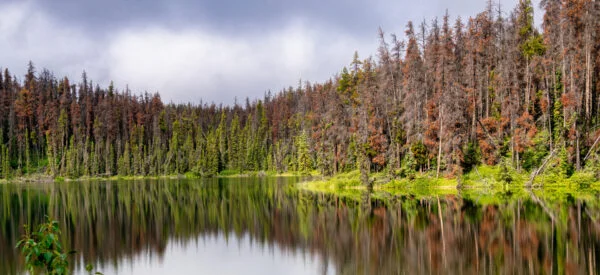Mountain Pine Beetle (MPB) Aerial Survey
Project Summary
In 2010 and 2012, our team successfully completed a large-scale project aimed at identifying and mitigating the spread of the destructive pine beetle in County of Grande Prairie, M.D of Greenview, M.D of Big Lakes and Wood Buffalo). Utilizing advanced photogrammetry techniques, we conducted aerial surveys, capturing remote data immediately after each flight. This data was processed and sent to government authorities within 10 days, allowing them to take prompt action in controlling the infestation. The entire project, valued at $680,000+$120,000, was completed within a week, demonstrating our capability to deliver rapid and efficient results in time-sensitive environmental projects.
Project Duration: 10 Days – September 2010 and 2012
Project Manager: Sally Wu
Estimated Project Budget: $680,000+$120,000
Approximate Hours: 1000
Service Delivered and Outcomes
Products Provided:
- 40Cm air photography acquisitions
- OrthoMosaicings
- Pine beetle Tree Interpolations and Statistics
- Remote data reports delivered to government agencies
Services Provided:
- Aerial surveys using aircraft
- Photogrammetry data collection and interpolations
- Rapid data processing and analysis
- Timely data delivery within 10 days
Data Outcomes:
- Precise identification of pine beetle trees
- Visualization of the potential spread of the pine beetle
- Actionable data for government intervention
- Geographic mapping of affected regions for monitoring and decision-making
Project Priority
- Time
- Quality
- Money
Problem Solved
By utilizing photogrammetry we were able to rapidly identify and contain the spread of the destructive pine beetles in Grande Prairie, Greenview, Big Lakes and Wood Buffalo. The aerial surveys and photogrammetric analysis allowed for quick detection of Pine Beetle tress, enabling government authorities to take timely and effective action. This helped to prevent the widespread damage to forests, saving time, resources, and reducing the potential long-term ecological and economic impact of the beetle’s spread.
Project Communication and Collaboration Summary
Our strong internal coordination, real-time data sharing, and consistent communication with GOA Alberta Sustainable Resource Development were critical to the project’s success, allowing for quick decision-making and efficient containment of the pine beetle threat.
Lessons Learned
- Speed is Critical in Environmental Crises: Rapid data collection and delivery were essential in containing the pine beetle infestation. Early detection and quick action can significantly reduce environmental and economic damage.
- Remote Sensing Technology is Highly Effective: Utilizing aerial surveys and photogrammetry provided accurate and comprehensive data in a short period, proving the value of advanced technology in addressing large-scale environmental challenges.
- Efficient Collaboration and Communication Matter: Quick coordination between the surveying team and government authorities ensured that the data was acted upon immediately, highlighting the importance of seamless communication in high-stakes projects.
- Cost-Effective Solutions are Possible with Technology: The project demonstrated that despite its scale, technology can provide an efficient and cost-effective solution ($680,000 for 10 days of work) compared to traditional methods.
- Preparedness for Future Projects: Having the right tools and processes in place, such as drones and photogrammetry software, prepared the team to handle similar urgent and large-scale environmental projects in the future.
Innovative Approaches and Outcomes
By leveraging photogrammetry, it allowed for rapid, large-scale data collection of 110 +67 Townships in central Alberta areas within 10 days. This technology allowed for detailed 3D models of infested areas allowing the Forest Management Branch, GOA to quickly identify pine beetle threats, significantly reducing response time. Delivering the flights, photos and processed data to the government within 10 days facilitated immediate action, preventing further spread. The project demonstrated a cost-effective, efficient method for environmental monitoring and set a new standard for crisis management, showcasing the value of technology and private-public collaboration in addressing ecological challenges.

